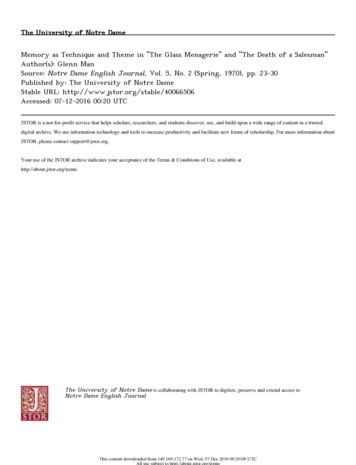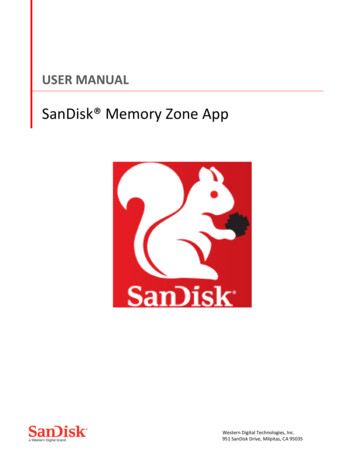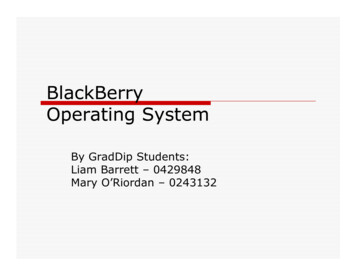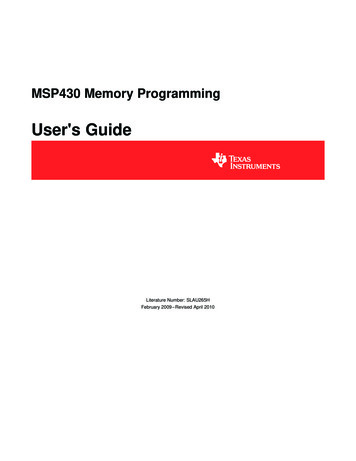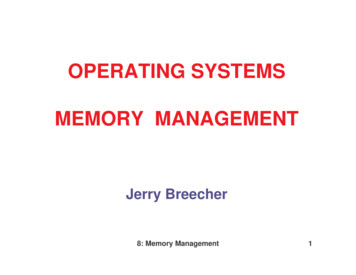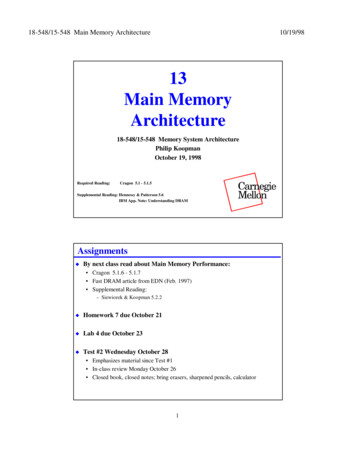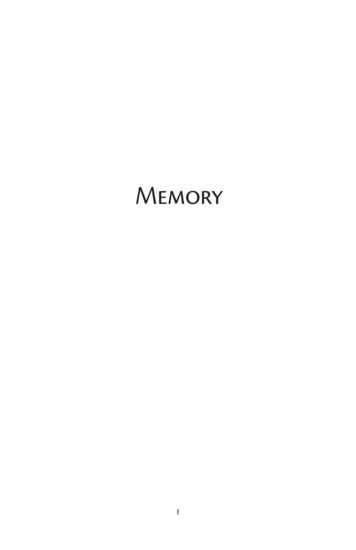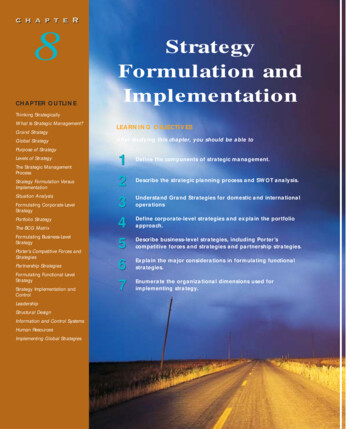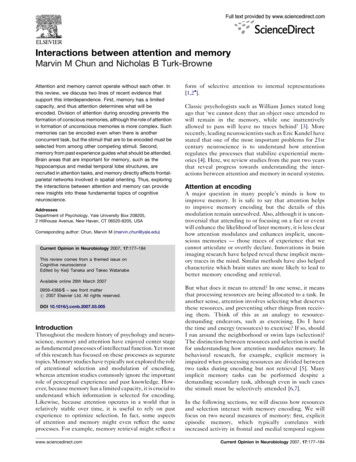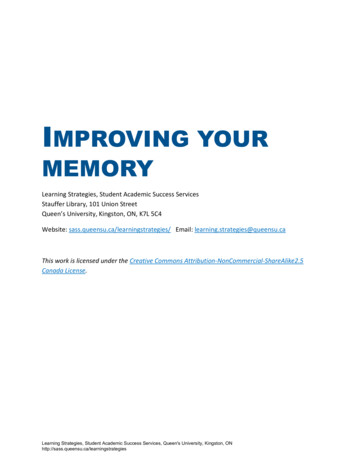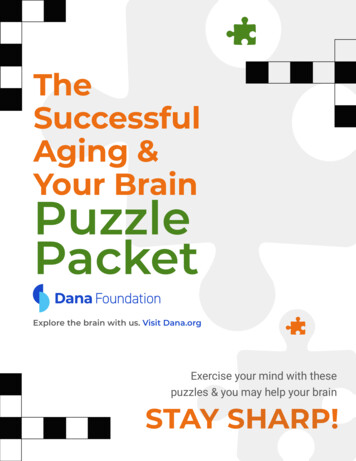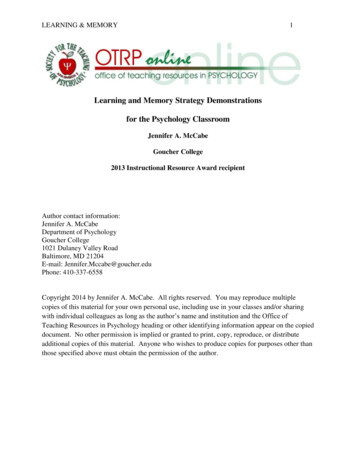
Transcription
LEARNING & MEMORY1Learning and Memory Strategy Demonstrationsfor the Psychology ClassroomJennifer A. McCabeGoucher College2013 Instructional Resource Award recipientAuthor contact information:Jennifer A. McCabeDepartment of PsychologyGoucher College1021 Dulaney Valley RoadBaltimore, MD 21204E-mail: Jennifer.Mccabe@goucher.eduPhone: 410-337-6558Copyright 2014 by Jennifer A. McCabe. All rights reserved. You may reproduce multiplecopies of this material for your own personal use, including use in your classes and/or sharingwith individual colleagues as long as the author’s name and institution and the Office ofTeaching Resources in Psychology heading or other identifying information appear on the copieddocument. No other permission is implied or granted to print, copy, reproduce, or distributeadditional copies of this material. Anyone who wishes to produce copies for purposes other thanthose specified above must obtain the permission of the author.
LEARNING & MEMORY2OverviewThis 38-page document contains an introduction to the resource, background information onlearning and memory strategies, a summary of research on undergraduate student metacognitionwith regard to these strategies, and a collection of classroom demonstrations that allows studentsto experience real-time the effectiveness of specific learning and memory strategies. Referencesare included at the end of the document.Table of ContentsPageI.Introduction3II.Background Information on Strategies and Metacognition4III. Classroom Demonstrations of Learning and Memory StrategiesA. Deep ProcessingB. Self-Reference EffectC. Spacing EffectD. Testing EffectE. ImageryF. ChunkingG. MnemonicsH. Generation Effect5610121617222530IV. References34V.38Acknowledgements
LEARNING & MEMORY3I. IntroductionThe purpose of this resource is to provide psychology instructors with an annotatedcollection of in-class learning and memory strategy demonstrations. The demonstrationsillustrate strategies that are empirically validated as effective for long-term memory retention andare readily applicable to both the psychology classroom and, more broadly, to college students’study skills.Teaching students about effective learning and memory strategies is a first step towardimproving metacognitive sophistication (i.e., learning how to learn); an important next step is tofind ways to encourage students to actually change their behaviors and implement thesestrategies in their daily lives, most notably in the context of learning information for collegecourses. One way psychology instructors can improve student exposure to, confidence in, andmotivation to implement the recommended learning strategies is to incorporate in-classdemonstrations of each strategy’s effectiveness. This technique allows students to witness inreal-time the memory advantage of certain strategies (e.g., imagery) over others (e.g., verbalrepetition).The demonstrations included in this resource represent an effort to translate research fromcognitive psychology into the arena of higher education. This translational piece has been afocus of recent publications from renowned researchers in the field (e.g., Dunlosky, Rawson,Marsh, Nathan, & Willingham, 2013; Roediger & Pyc, 2012). As such, researchers inpsychological science now ask (and ideally answer) questions regarding what their basic researchfindings imply for real-world educational practice. This resource will help teachers explore oneway to translate research findings into the everyday experience of college students.This project is relevant to teachers of psychology on multiple levels. First, teachers whoinclude a section on human memory in their courses (e.g., Introduction to Psychology, CognitivePsychology, Learning and Memory) may benefit from a teaching resource that includes evidencefor beneficial learning and memory strategies. At a basic level, incorporating this informationand these demonstrations into such classes should improve students’ knowledge about howmemory works. Second, this resource may be particularly valuable to those who teach first-yearand/or underprepared students, as these students may especially need training in themetacognitive aspects of learning how to learn. At an applied level, these demonstrationsillustrate in real-time the memory benefits of specific strategies, and then class discussion andfollow-up assignments could encourage students to implement such strategies in their collegecourses and also in memory tasks in their everyday lives. For advanced courses in particular, thedemonstrations can provide an effective scaffold for discussions of memory theories.As teachers of psychology, we have a responsibility to share the research findings in ourdiscipline with students to help them acquire the skills for lifelong learning. It is one thing to tellstudents about the best way to learn, but quite another to show them that some strategies aremore successful than others. This “aha” moment in class when, for example, students realizethat all it took was a bit of mental imagery to improve memory far beyond verbal repetition, isrewarding for students and educators alike. This resource provides teachers with the materials tohelp their students engage in interesting exercises aimed at helping them become more strategicand successful learners.
LEARNING & MEMORY4II. Background Information on Strategies and MetacognitionA large body of literature now exists to document, at least in the laboratory, the memorybenefits of learning strategies such as deep (elaborative) processing (e.g., Craik & Lockhart,1972), the self-reference (i.e., self-referential processing) effect (e.g., Rogers, Kuiper, & Kirker,1977), spaced study (or distributed practice; e.g., Rohrer & Pashler, 2007), retrieval practice (thetesting effect; Roediger & Karpicke, 2006), imagery (dual-coding; Paivio, 1986), chunking (e.g.,Butterworth, Shallice, & Watson, 1990), mnemonics (e.g., Bellezza, 1996; for a review, seeMcCabe, 2011a), and learner-created study materials (the generation effect; e.g., Slamecka &Graf, 1978). See Roediger and Pyc (2012) for a review of several of these strategies.Although research has established the strategies listed above as beneficial for memory,compelling evidence suggests that many college students have low metacognitive awareness, sothese strategies could be helpful for their learning (Kornell & Bjork, 2007; McCabe, 2011b).This lack of awareness may be particularly relevant to those strategies that Bjork (1994) termeddesirable difficulties, the types of activities that make learning slower and more error-prone inthe short term, but have longer-term memory benefits. Research shows that college studentssometimes believe that the opposite of effective strategies are best for memory (e.g., re-readingversus retrieval practice, or testing; e.g., McCabe, 2011b; Roediger & Karpicke, 2006). Inaddition, many strategies self-reported by undergraduates are non-elaborative and unsupportedby research (e.g., re-reading, highlighting; Hartlep & Forsyth, 2000; Karpicke, Butler, &Roediger, 2009). As learners may not have metacognitive sophistication to judge the mosteffective learning methods on their own, it is critical that instructors assist them in acquiringthese beneficial techniques.Basic research suggests that learners are more likely to use a strategy that they haveexperienced as beneficial for their own memory (e.g., Bjork, deWinstanley, & Storm, 2007;Murphy, Schmitt, Caruso, & Sanders, 1987). Thus, demonstrating the most effective strategiesin class could help improve strategic choices and minimize the metacognitive disconnect notedabove. Specific to mnemonic techniques, Carney, Levin, and Levin (1994) recommended thatinstructors provide in-class “mnemonstrations,” with the goal that students would then take moreownership of mnemonic creation and use over time. Based on empirical research conducted inhis introductory psychology class, Balch (2005) suggested that instructors teach students aboutelaborative methods such as keyword mnemonics and real-life examples by including these inlecture materials. In a more holistic approach to memory strategy instruction, Shimamura (1984)developed an entire short course focusing on memory skills, emphasizing that instructors musttake the time to provide training and practice to bolster successful strategy use.My own research has shown that explicit in-class instruction about effective learningtechniques is associated with improved knowledge of these “desirably difficult” strategies(McCabe, 2011b). Others have demonstrated that instruction on applied learning and memorytopics is associated with increased metacognition and subsequent academic performance (e.g.,Azevedo & Cromley, 2004; Fleming, 2002; Tuckman, 2003). Assuming that instructors wantstudents to change their strategic study behaviors, one way to make progress toward this goal isto integrate learning and memory strategy demonstrations into the psychology classroom.
LEARNING & MEMORY5III. Classroom Demonstrations for Learning and Memory StrategiesThis section is organized by type of learning strategy, based more broadly on principlesof memory improvement. Each section includes a brief description of the strategy with keyreferences, at least one classroom demonstration, and when available, empirical support for thedemonstration’s effectiveness.The demonstrations described below were chosen using the following inclusion criteria:1) The demonstration fits within class time.2) The demonstration includes a comparison between a strategy that improves memory anda strategy that works less well, in a between-subjects or within-subjects manner.3) The outcomes of the demonstration should clearly illustrate the superiority of theempirically supported strategy.4) The demonstrated strategy is one that has obvious links to academic behaviors understudents’ control; that is, students could apply the strategy to their own studying, ideallyenhancing self-regulated learning outside the classroom.
LEARNING & MEMORY6A. DEEP PROCESSINGDescription of the strategy: Deep processing involves elaborating on to-be-learned informationin a semantic (meaning-based) way. Research suggests that semantic (deep) processing of itemsis superior to phonological (medium) or structural/orthographic (shallow) processing for longterm memory (e.g., Craik, 2002; Craik & Lockhart, 1972); Craik & Tulving, 1975).Deep Processing Demonstration #1Using an abbreviated version of Craik and Tulving’s (1975) levels-of-processing experiment,Bugg, DeLosh, and McDaniel (2008) assessed the impact of an in-class exercise thatdemonstrated the memory advantage of deep/semantic over shallow/nonsemantic processingusing a within-subjects design. Students view 18 words one at a time for 2 seconds each. Foreach word, they answer a yes/no “orienting question” that represents processing at ashallow/orthographic (e.g., “Is it typed in capital letters?”), medium/phonological (e.g., “Does itrhyme with ‘shock’?”), or deep/semantic (e.g., “Does it fit in the sentence ‘The wasbuilding a nest.’”) level. After a brief filled delay, students are given 60 seconds to recall thewords. The instructor then asks for a show of hands to tally which level of recall was highest.According to Bugg et al., the demonstration clearly shows that the deep/semantic orientingquestions resulted in the best memory for the words. In addition, students in their study ratedsemantic study strategies as more useful than nonsemantic strategies after the activity,demonstrating a lasting impact from the demonstration.The activity takes approximately 7 minutes. A presentation using PowerPoint containing thedemonstration is available at http://lamar.colostate.edu/ delosh/downloads.htm
LEARNING & MEMORY7Deep Processing Demonstration #2Chew (2010) reported a demonstration using a 2 (Level of Processing: deep, shallow) x 2 (Intentto Learn: intentional, incidental) between-group factorial design. This works best in classes withat least 40 students. (For classes with fewer students, eliminate the intent variable.) Theinstructor reads a list of words aloud; depending on the instructions given at the top of an answersheet, for each word students engage in an orienting task that is either shallow (i.e., “Does theword contain an E or G?”) or deep (“Is the word pleasant?”). In addition, half of the class isinformed it will take a memory test on the words (intentional condition) and half is not informed(incidental).The demonstration requires four handouts, each with the instructions for the relevant condition:deep/intentional, deep/incidental, shallow/intentional, shallow/incidental. Divide the room intoquadrants and distribute one type of encoding instruction to that quadrant. The instructor reads24 words as the students answer the yes/no question they are assigned:(1) Evening(2) Country(3) Salt(4) Easy(5) Peace(6) Morning(7) Pretty(8) Expensive(9) Poor(10) Doctor(11) City(12) Dry(13) Cold(14) Love(15) Bargain(16) War(17) Hate(18) Wet(19) Rich(20) Nurse(21) Pepper(22) Hard(23) Ugly(24) HotAfter explaining the four conditions, the instructor has the entire class stand and remain standingonly if they recalled at least three words. As higher recall numbers are read, more and morestudents sit down. Chew (2010) reported it should be apparent at 12-15 words recalled that themajority of people still standing engaged in deep processing, and that it does not much matterwhether they were warned or not warned about the recall test. He used this as evidence thatintention to learn is far less important than what students think about while they are studying. Asan extension of the activity, the instructor can ask who noticed that the word list contained pairsof opposites. Typically, the deep processing groups notice it and the shallow processing groupsoften do not.This demonstration takes approximately 10 minutes.
LEARNING & MEMORY8Deep Processing Demonstration #3Pusateri (2003) created a slideshow using PowerPoint to demonstrate the effectiveness of deepprocessing. Distribute papers with one of two sets of instructions:[Shallow processing group]Instructions: For this demonstration, you will see a series of words numbered from 1 to 20.When you see each word, circle “Yes” if the word contains the letter E and “No” if it doesn’tcontain a letter E.[Followed by the numbers 1 through 20, each with “Yes” and “No” listed adjacent.][Deep processing group]Instructions: For this demonstration, you will see a series of words numbered from 1 to 20.When you see each word, circle “Yes” if the word sounds pleasant to you and “No” if it doesn’tsound pleasant to you.[Followed by the numbers 1 through 20, each with “Yes” and “No” listed adjacent.]Next, all students see the following instructions on the screen: “You will see a list of 20 words.Follow the instructions on your sheet as you see each word. The words will appear relativelyquickly, so make a quick decision for each word.” Each of the following words appears on thescreen for 2 seconds each:(1) Table(2) Night(3) Red(4) Love(5) Salt(6) Happy(7) North(8) Mother(9) High(10) Odd(11) Hate(12) Father(13) Day(14) Green(15) Even(16) Chair(17) Pepper(18) Low(19) Sad(20) SouthStudents are immediately asked to write down as many of the words as they can remember, inany order.
LEARNING & MEMORY9Next, to score their own recall performance, students are shown the words as semantic pairs, asfollows:TABLE - CHAIRNIGHT - DAYRED - GREENLOVE - HATESALT - PEPPERHAPPY - SADNORTH - SOUTHMOTHER - FATHERHIGH - LOWODD - EVENThe rationale for showing the items in pairs is so that students can easily compute a “clustering”score (number of semantic pairs listed together out of 10) in addition to a basic recall score(number of items recalled out of 20). The instructor can collate the class data to complete thefollowing matrix:RECALLCONTAINS AN “E”?PLEASANT OR NOT?CLUSTERINGResults should clearly show an advantage for the pleasantness-rating (deep) group over the Erating (shallow) group. In addition, clustering scores should be higher for the deep than for theshallow group. Many students in the shallow condition may not have realized there were clustersin the list at all, as they were focusing only on surface features of the words.PowerPoint-based materials for this demonstration are available from Tom Pusateri athttps://files.kennesaw.edu/xythoswfs/webui/ xy-1257263 1-t IdbunvA5(Chapter 6 folder, “Deep Processing” demo)This demonstration takes approximately 10 minutes.
LEARNING & MEMORY10B. SELF-REFERENCE EFFECTDescription of the strategy: The self-reference effect (or self-referential processing) refers tothe memory advantage for material personally related to the learner. Information that is attachedto the self-schema is more easily encoded and later retrieved (e.g., Klein & Kihlstrom, 1986;Rogers et al., 1977).Self-Reference Effect Demonstration #1This demonstration is based on Forsyth and Wibberly’s (1993) report of a within-subjectsdemonstration of the self-reference effect. Each student should number a paper from 1 to 18, andthen the instructor reads the following list of 18 adjectives aloud. For each word, students circlethe number corresponding to the word if they think it describes themselves. The items are:(1) Forceful(2) Quiet(3) Generous(4) Dominant(5) Tender(6) Loyal(7) Independent(8) Compassionate(9) Adaptable(10) Courageous(11) Cheerful(12) Secretive(13) Principled(14) Romantic(15) Responsible(16) Dynamic(17) Forgiving(18) CarefulAfter a 1-minute delay filled with a backward counting task, the instructor asks students to recallthe adjectives in any order. Students count the number of self-referent words they recalled andthe number of non-self-referent words recalled, then convert those to percentages of recall.In Forsyth and Wibberly (1993), students recalled 42.5% of non-self-referent words, and 56.0%of self-referent words. This is a practical and effective way to demonstrate the self-referenceeffect (and the related concept of depth of processing in the classroom).This demonstration takes approximately 8 minutes.
LEARNING & MEMORY11Self-Reference Effect Demonstration #2Rogers et al. (1977) extended Craik and Lockhart’s (1972) and Craik and Tulving’s (1975)levels-of-processing theory to include a self-referencing condition. This extension can easily beadapted to become a 3-condition between-subjects classroom demonstration.Before starting the demonstration, 1/3 of the class is given sheets numbered 1 through 16 thatinstruct them to count and write down the number of vowels in each word (shallow condition);1/3 of the class is given instructions to rate the pleasantness of the word on a 1 (very unpleasant)to 5 (very pleasant) scale (deep/semantic condition); and 1/3 is given instructions to rate theextent to which the word describes them on a 1 (does not describe me at all) to 5 (very muchdescribes me) scale (deep/self-reference condition). Students are not told that they will be takinga recall test. Next, the instructor should visually present this list of 16 words:(1) Serious(2) Artistic(3) Trusting(4) Gentle(5) Timid(6) Warm(7) Clumsy(8) Lazy(9) Loyal(10) Rigid(11) Reckless(12) Brave(13) Honest(14) Rude(15) Wise(16) TenseFollowing the list, students are asked to recall as many words as they can in any order and toscore their own recall lists. Class results should show the highest recall in the two deepprocessing conditions compared to the shallow condition, and even higher recall in the selfreferential compared to the standard semantic-processing condition.This demonstration takes approximately 8 minutes.
LEARNING & MEMORY12C. SPACING EFFECTDescription of the strategy: The spacing effect refers to the memory advantage of distributingstudy time with breaks in between, as compared to massing or cramming study time into onlyone session, holding total study time constant (e.g., Cepeda, Pashler, Vul, Wixted, & Rohrer,2006; Kornell & Bjork, 2007; Rundus, 1971; Smith & Rothkopf, 1984).Spacing Effect Demonstration #1The following demonstration is adapted from Balch (2006), who reported the outcomes of awithin-subjects demonstration that compared memory for words that were studied in a massedversus spaced manner. The instructor should tell students they will hear a list of words readaloud for them to remember, at a pace of one every 3 seconds, and to expect that most of thewords would appear twice in the list. Thirty-six 2-syllable words are then presented to the class(below), including buffer words in the first four positions that are not included in the recall total(to avoid contamination from the primacy effect).(1) Vessel(2) Household(3) Household(4) Tower(5) Message(6) Basket(7) Basket(8) Fashion(9) Justice(10) Justice(11) Artist(12) Supper(13) Fashion(14) Ticket(15) Ticket(16) Remark(17) Cousin(18) Message(19) Leather(20) Leather(21) Artist(22) Witness(23) Witness(24) Pattern(25) Bottle(26) Empire(27) Empire(28) Pattern(29) Cousin(30) Giant(31) Giant(32) Supper(33) Remark(34) Habit(35) Habit(36) BottleAfter the presentation of the list, students count backward by 3’s from a three-digit number (e.g.,245) for 18 seconds, to avoid contamination from the recency effect due to items in short-termmemory. Then they are asked to recall as many words as possible in any order, in 2 minutes.Within the list, ignoring the first four buffer words, eight words are presented in aspaced/distributed fashion, in that other words intervene between the repetition of that word (i.e.,for message, fashion, artist, supper, remark, cousin, pattern, bottle) and eight words are
LEARNING & MEMORY13presented in a massed fashion (i.e., immediate repetition for basket, justice, ticket, leather,witness, empire, giant, habit). Students tally the number of “spaced” words out of eight that theyrecalled, and the number of “massed” words out of eight that they recalled. By a show of hands,students can indicate whether they recalled more “spaced” than “massed” words, more “massed”than “spaced,” or the same number of each type.Balch’s (2006) results showed that students recalled significantly more distributed/spaced words(47.8%) than massed words (34.5%). In addition, students performed better on quiz questionsabout the spacing effect (and other research design elements contained in the demonstration)after the demonstration compared to before the demonstration. Finally, students reported feelingconvinced of the benefits of distributing study over time and also reported high enjoyment of theactivity.This demonstration takes approximately 10 minutes.
LEARNING & MEMORY14Spacing Effect Demonstration #2An online demonstration of the spacing effect, similar to Balch’s (2006) activity describedabove, is available at Timothy Bender’s web r/mem/mydemos.html#recentThis demonstration takes approximately 10 minutes.
LEARNING & MEMORY15Spacing Effect Demonstration #3The spacing effect can also be demonstrated over a longer time course (i.e., beyond one classperiod) by asking students to study a set of terms and definitions at the start of class. Perhaps theterms could be relevant to an upcoming chapter in the course. For half the terms, students studyin a massed fashion (e.g., a total of 6 minutes during one class period) For the other half,students study in a distributed fashion (e.g., 3 minutes during one class, then 3 minutes during asecond class, with a break in between). A recall test given during a subsequent class periodshould show an advantage for spaced over massed study.Depending on the length of the study sessions and the number of items to be recalled on the test,this demonstration should take approximately 15-20 minutes of total class time across two days.
LEARNING & MEMORY16D. TESTING EFFECTDescription of the strategy: The testing effect states that practicing retrieval of informationfrom long-term memory enhances retention more than continued study of the information. Thisis also known as retrieval-based learning (e.g., Karpicke, 2012; McDaniel, Howard, & Einstein,2009; Roediger & Karpicke, 2006)Testing Effect DemonstrationEinstein, Mullet, and Harrison (2012) developed a within-subjects activity to allow students toexperience and understand the testing effect.To conduct this demonstration in class, two 1-page passages are required. Einstein et al. (2012)used passages from a preparation book for the Test of English as a Foreign Language. The Sunand Sea Otter passages can be found at ger&Karpicke2006b.pdf.During one class period, students should read Passage A (a short prose passage) using a StudyStudy strategy, then Passage B using a Study-Test strategy. For Study-Study, students read thepassage for 4 minutes, then re-read it for another 4 minutes. For Study-Test, students read for 4minutes, then spend a 4-minute test period writing as much as they can remember about thepassage. Then have students rate how well they thought they learned from each condition. Oneweek later, administer a surprise quiz on each passage, each consisting of 12 short-answer items.Students have 7 minutes to take each quiz. The short-answer questions and answers can befound at a%20Otter%20Quiz.pdfStudents score their own quizzes as the instructor reads aloud the correct answers, out of amaximum of 12 for each quiz.Einstein et al. (2012) showed that a testing effect in the class data (59% correct for Study-Test;52% correct for Study-Study). Based on self-report, students did not think that one strategy wasmore effective than the other. However, at the end of the semester, students reported havingchanged their study habits, being more likely to use testing as a memory strategy when readingand studying.
LEARNING & MEMORY17E. ImageryDescription of the strategy: The use of visual imagery helps memory for to-be-learned material.Dual-coding theory states that having both verbal and image-based encoding enhances thenumber of routes for retrieval, and therefore enhances memory success (Paivio, 1986; see alsoBower & Winzenz, 1970; Paivio, Smythe, & Yuille, 1968).Imagery Demonstration #1Based on Paivio et al. (1968), Pusateri (2003) developed a paired-associates learningdemonstration using PowerPoint that quickly and reliably demonstrates the superiority ofencoding words that can be readily imagined (concrete) over those than cannot (abstract).Read the following instructions to students: In this demonstration, you will see 14 pairs of words,each containing a STIMULUS and a RESPONSE. Try to remember the pairs of words so thatlater, when you see the STIMULUS word, you’ll remember the RESPONSE word. Use whatevertechniques you can think of to recall each pair of words. You’ll have 5 seconds to see each pair.The slideshow then presents the 14 word pairs one at a time for 5 seconds each: hatchet – leafcause – meaningsofa – bicyclejudgment – concernmuseum – antelopetruck – applemountain – calendarpurpose – valuesubstance – dutyevent – conceptcarton – bottleocean – newspaperreason – freedomdecision – programThen read the next instruction: Write the number 1 through 14 on a sheet of paper. On the nextseveral slides, you’ll see each of the “STIMULUS” words. Try to recall the “RESPONSE”words. You’ll have 7 seconds to recall each RESPONSE.1.2.3.4.5.truck - ?purpose - ?carton - ?substance - ?sofa - ?
LEARNING & MEMORY186. judgment - ?7. mountain - ?8. decision - ?9. hatchet - ?10. cause - ?11. museum - ?12. reason - ?13. ocean - ?14. event - ?Next, students check their memory on the next slide, and specifically count how many evennumbered words they recalled correctly (out of 7) and how many odd-numbered words theyrecalled correctly (out of 7).1. TRUCK – APPLE3. CARTON – BOTTLE5. SOFA – BICYCLE7. MOUNTAIN – CALENDAR9. HATCHET – LEAF11. MUSEUM – ANTELOPE13. OCEAN – NEWSPAPERRECALL OF ODD WORD PAIRINGS (CONCRETE): / 72. PURPOSE – VALUE4. SUBSTANCE – DUTY6. JUDGMENT – CONCERN8. DECISION - PROGRAM10. CAUSE – MEANING12. REASON – FREEDOM14. EVENT – CONCEPTRECALL OF EVEN WORD PAIRINGS (ABSTRACT): / 7Either by a show of hands (e.g., asking students to raise their hands if they recalled more wordsfor the even items than the odd items) or by more formal methods of data analysis (e.g.,collecting recall scores and running a paired-samples t test on the means), a clear advantage foreasily visualizable words should be found.PowerPoint-based materials for this demonstration are available from Tom Pusateri at:https://files.kennesaw.edu/xythoswfs/webui/ xy-1257263 1-t IdbunvA5(Chapter 9 folder, “Dual Coding” demo)This demonstration takes approximately 10 minutes.
LEARNING & MEMORY19Imagery Demonstration #2A similar in-class demonstration could be easily modeled on Bower and Winzenz (1970), whoshowed a significant memory benefit for participants who used an imagery strategy to memorizeword pairs compared to those using a verbal repetition strategy. In a between-subjectsmodification to the Pusateri (2003) demonstration described above, give half the classinstructions to encode the word pairs using a word repetition strategy and give the other halfinstructions to encode the pairs using visual imagery. An example would be presenting the wordpair “boat – tree,” with the expectation that the repetition group would silently repeat, “boat –tree, boat – tree, boat – tree,” and that the imagery group would instead use an interactive mentalpicture to encode the words (e.g., a boat sitting on top of a tree). Then a series of concrete nounpairs should be presented in a format similar to the Pusateri demonstration above, followed bycued recall of the second word of the pair when provided with the first word, then a discussion ofclass results that should show better memory for the
LEARNING & MEMORY 5 III. Classroom Demonstrations for Learning and Memory Strategies This section is organized by type of learning strategy, based more broadly on principles of memory improvement. Each sect
